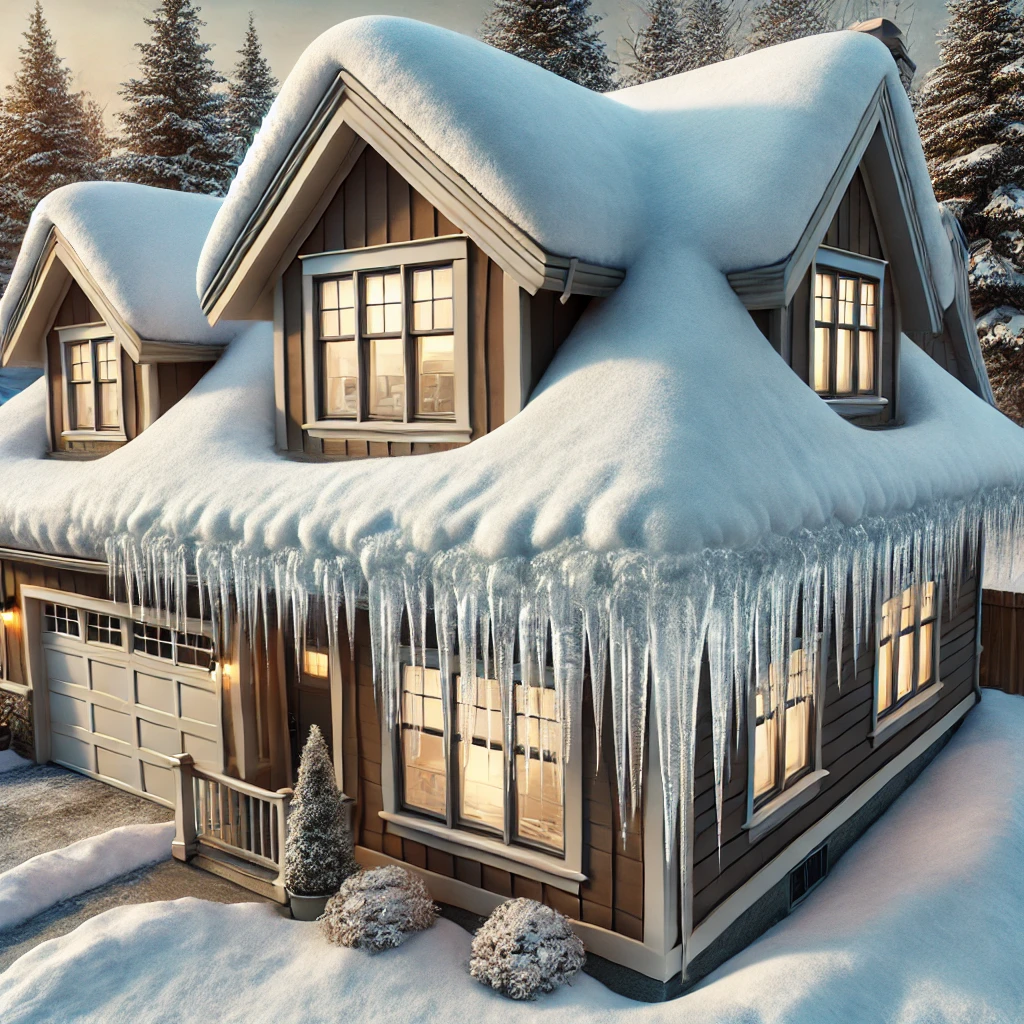Why Is My Roof Leaking From Ice Dams?
Winter brings a picturesque view of snow-covered rooftops, but for many homeowners, it can also bring an unwelcome problem: ice dams. If your roof starts leaking in freezing weather, ice dams are a likely culprit. These wintertime nuisances can cause significant damage to your home if left unchecked. Let’s explore what ice dams are, why they form, and how you can prevent them from wreaking havoc on your home.
What Are Ice Dams?
Ice dams are ridges of ice that form along the edges of your roof. They prevent melting snow from draining off, causing water to back up under the shingles and leak into your home.
How They Form
- Uneven Roof Temperatures: Ice dams form when the upper part of your roof is warm enough to melt snow, while the edges remain cold and allow the melted water to refreeze.
- Snow Accumulation: A thick blanket of snow on the roof provides the raw material for ice dams.
- Melting and Refreezing: As the snow melts and flows to the cooler roof edges, it refreezes, forming a dam of ice. Over time, this dam grows and traps more water behind it, increasing the risk of leaks.
What Causes Ice Dams?
Several factors contribute to the formation of ice dams:
1. Heat Escaping From Your Home
- Poor insulation and air leaks allow warm air from inside your house to rise into the attic, warming the roof surface and causing snow to melt unevenly.
2. Inadequate Ventilation
- Without proper ventilation, heat becomes trapped in the attic, raising the roof’s temperature and accelerating snowmelt.
3. Weather Conditions
- Cycles of freezing and thawing, combined with heavy snowfall, create the perfect environment for ice dams to develop.
Why Are Ice Dams a Problem?
Ice dams are more than just a nuisance—they can lead to serious damage if not addressed promptly.
1. Roof Leaks
Trapped water can seep under shingles, damaging your roof deck and eventually leaking into your home.
2. Structural Damage
Prolonged exposure to water can weaken your roof, walls, and ceilings. Mold and mildew can also develop, leading to health risks.
3. Gutter Damage
The weight of ice dams can strain or even tear gutters away from your home, leading to costly repairs.
4. Increased Energy Bills
Ice dams are often a sign of poor insulation, meaning your home may be losing heat and driving up energy costs.
How to Prevent Ice Dams
Preventing ice dams is a multi-step process that addresses the underlying causes. Here are some effective strategies:
1. Improve Attic Insulation
- Ensure your attic is well-insulated to keep warm air from escaping into the roof space. A properly insulated attic maintains a uniform roof temperature, reducing the risk of snowmelt at the roof’s peak.
2. Seal Air Leaks
- Identify and seal any gaps or cracks where warm air might escape into the attic, such as around recessed lighting, vent pipes, or chimneys.
3. Enhance Ventilation
- Proper attic ventilation helps maintain a consistent roof temperature by allowing cold air to circulate and expelling warm air. Soffit and ridge vents are commonly used to achieve this balance.
4. Remove Snow Safely
- After heavy snowfall, use a roof rake to remove snow from the edges of your roof. This can prevent the buildup of ice before it begins.
- Avoid using sharp tools or climbing onto a slippery roof, as this can be dangerous and cause damage.
5. Install Ice and Water Shields
- When replacing your roof, consider installing an ice and water shield along the eaves. This waterproof barrier provides extra protection against leaks.
6. Use Heating Cables
- Heating cables can be installed along roof edges to melt snow and prevent ice dams from forming. However, they should be used cautiously and only as part of a broader prevention strategy.
What to Do If You Already Have an Ice Dam
If you discover an ice dam causing a roof leak, here’s what to do:
1. Act Quickly
- Use a roof rake to remove as much snow as possible from the roof’s edge. This reduces the amount of water that can freeze.
2. Create Channels
- Use warm water to create channels in the ice dam, allowing trapped water to escape. Avoid using salt or chemicals, as they can damage your roof.
3. Consult a Professional
- If the ice dam is too large or the damage is severe, contact a roofing professional to safely remove the ice and repair any leaks.
Final Thoughts
Ice dams are a serious concern for homeowners in cold climates, but they are preventable with the right combination of insulation, ventilation, and proactive maintenance. By understanding how ice dams form and taking steps to prevent them, you can protect your home from winter’s icy grip.
If you’re dealing with persistent ice dams or worried about your roof’s performance, consider consulting a roofing expert to assess your home’s needs and recommend tailored solutions. After all, a little preparation now can save you from big headaches later.

